Black and Hispanic children underrepresented at diabetes summer camps

During 2018, black and Hispanic children attended diabetes summer camps less frequently than white children, according to findings published in Diabetes Care.
“Diabetes camps offer a lot of benefits to youth with diabetes and should be accessible to all children,” Risa M. Wolf, MD, assistant professor of pediatrics at Johns Hopkins Medicine, told Healio. “Racial disparities exist in many aspects of diabetes care and outcomes, including diabetes camp attendance. Therefore, we need to identify what the barriers are and address them to make camp attendance more inclusive.”
Using a registration database, Wolf and colleagues assessed the racial and ethnic makeup, continuous glucose monitor usage, insulin delivery technique, camp type and financial aid requirements of 5,256 children (mean age, 11.8 years; 55% girls) who attended American Diabetes Association-affiliated summer camps in 2018.
Among the cohort, 16.3% of participants were of nonwhite ethnicity. The researchers’ analysis, which incorporated 2009 SEARCH for Diabetes in Youth data on prevalence of type 1 diabetes among U.S. children by ethnicity, revealed that camp attendance was “less likely” for black, Hispanic and Pacific/Islander children and “more likely” for white and American Indian children.

Among those who attended camp, 31.9% of Hispanic children, 23.3% of black children and 20% of white children went to day camp vs. residential camp. In addition, 48.4% of black children, 44% of Hispanic children and 29.2% of white children were going to camp for the first time. In order to attend, 65.6% of black children, 48.1% of Hispanic children and 24.3% of white children applied for financial aid.
Insulin was delivered via pump for 39.1% of black children, 60.3% of Hispanic children and 76.4% of white children while 23.4% of black children, 46.1% of Hispanic children and 61% of white children used CGM. Mean HbA1c was 9.5% among black children, 8.8% among Hispanic children and 8.2% among white children.
“Johns Hopkins pediatric endocrinology and the ADA started a new diabetes camp, Camp Charm City, in summer 2019 that is a day camp, located in Baltimore City, with a very low registration cost; 31% of children in attendance were minority youth,” Wolf said. “Similar initiatives to this one may help increase accessibility and reduce these disparities.” – by Phil Neuffer
For more information:
Risa M. Wolf, MD, can be reached at rwolf@jhu.edu.
Disclosures: Wolf reports no relevant financial disclosures. Please see the study for all other authors’ relevant financial disclosures.

